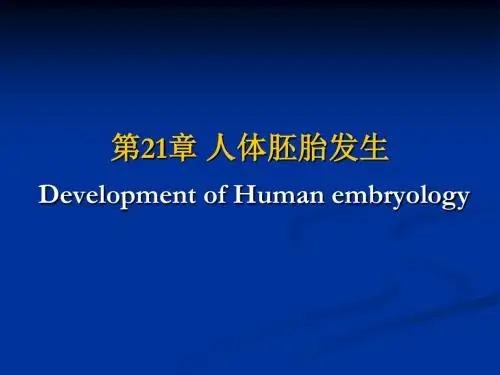体细胞胚胎发生副本共40页文档
- 格式:ppt
- 大小:4.50 MB
- 文档页数:40
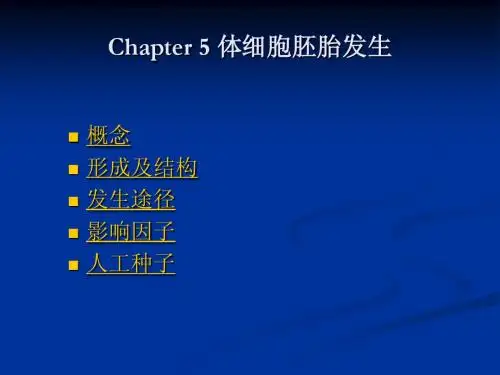
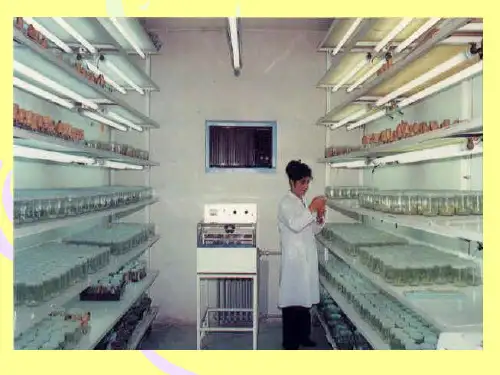


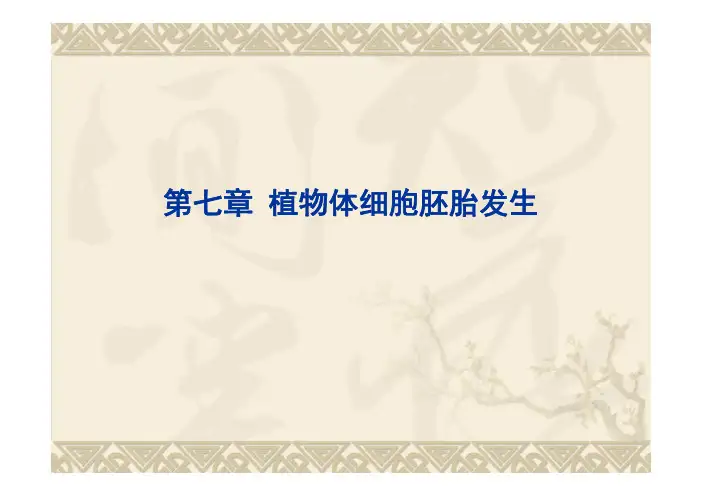


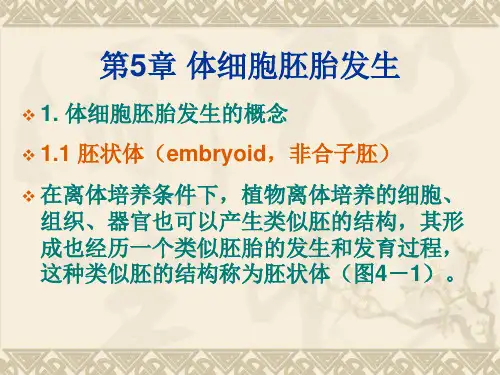
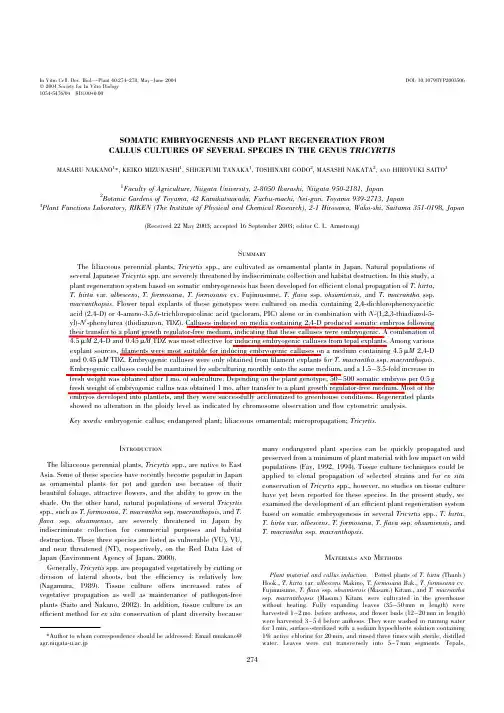
SOMATIC EMBRYOGENESIS AND PLANT REGENERATION FROM CALLUS CULTURES OF SEVERAL SPECIES IN THE GENUS TRICYRTISMASARU NAKANO 1*,KEIKO MIZUNASHI 1,SHIGEFUMI TANAKA 1,TOSHINARI GODO 2,MASASHI NAKATA 2,ANDHIROYUKI SAITO 31Faculty of Agriculture,Niigata University,2-8050Ikarashi,Niigata 950-2181,Japan2Botanic Gardens of Toyama,42Kamikutsuwada,Fuchu-machi,Nei-gun,Toyama 939-2713,Japan3Plant Functions Laboratory,RIKEN (The Institute of Physical and Chemical Research),2-1Hirosawa,Wako-shi,Saitama 351-0198,Japan(Received 22May 2003;accepted 16September 2003;editor C.L.Armstrong)SummaryThe liliaceous perennial plants,Tricyrtis spp.,are cultivated as ornamental plants in Japan.Natural populations of several Japanese Tricyrtis spp.are severely threatened by indiscriminate collection and habitat destruction.In this study,a plant regeneration system based on somatic embryogenesis has been developed for efficient clonal propagation of T.hirta ,T.hirta var.albescens ,T.formosana ,T.formosana cv.Fujimusume,T.flava ssp.ohsumiensis ,and T.macrantha ssp.macranthopsis .Flower tepal explants of these genotypes were cultured on media containing 2,4-dichlorophenoxyacetic acid (2,4-D)or 4-amino-3,5,6-trichloropicolinic acid (picloram,PIC)alone or in combination with N -(1,2,3-thiadiazol-5-yl)-N 0-phenylurea (thidiazuron,TDZ).Calluses induced on media containing 2,4-D produced somatic embryos following their transfer to a plant growth regulator-free medium,indicating that these calluses were embryogenic.A combination of 4.5m M 2,4-D and 0.45m M TDZ was most effective for inducing embryogenic calluses from tepal explants.Among various explant sources,filaments were most suitable for inducing embryogenic calluses on a medium containing 4.5m M 2,4-D and 0.45m M TDZ.Embryogenic calluses were only obtained from filament for T.macrantha ssp.macranthopsis .Embryogenic calluses could be maintained by subculturing monthly onto the same medium,and a 1.5–3.5-fold increase in fresh weight was obtained after 1mo.of subculture.Depending on the plant genotype,50–500somatic embryos per 0.5g fresh weight of embryogenic callus was obtained 1mo.after transfer to a plant growth regulator-free medium.Most of the embryos developed into plantlets,and they were successfully acclimatized to greenhouse conditions.Regenerated plants showed no alteration in the ploidy level as indicated by chromosome observation and flow cytometric analysis.Key words:embryogenic callus;endangered plant;liliaceous ornamental;micropropagation;Tricyrtis .IntroductionThe liliaceous perennial plants,Tricyrtis spp.,are native to East Asia.Some of these species have recently become popular in Japan as ornamental plants for pot and garden use because of their beautiful foliage,attractive flowers,and the ability to grow in the shade.On the other hand,natural populations of several Tricyrtis spp.,such as T.formosana ,T.macrantha ssp.macranthopsis ,and T.flava ssp.ohsumiensis ,are severely threatened in Japan by indiscriminate collection for commercial purposes and habitat destruction.These three species are listed as vulnerable (VU),VU,and near threatened (NT),respectively,on the Red Data List of Japan (Environment Agency of Japan,2000).Generally,Tricyrtis spp.are propagated vegetatively by cutting or division of lateral shoots,but the efficiency is relatively low (Nagamura,1989).Tissue culture offers increased rates of vegetative propagation as well as maintenance of pathogen-free plants (Saito and Nakano,2002).In addition,tissue culture is an efficient method for ex situ conservation of plant diversity becausemany endangered plant species can be quickly propagated and preserved from a minimum of plant material with low impact on wild populations (Fay,1992,1994).Tissue culture techniques could be applied to clonal propagation of selected strains and for ex situ conservation of Tricyrtis spp.,however,no studies on tissue culture have yet been reported for these species.In the present study,we examined the development of an efficient plant regeneration system based on somatic embryogenesis in several Tricyrtis spp.,T.hirta ,T.hirta var.albescens ,T.formosana ,T.flava ssp.ohsumiensis ,and T.macrantha ssp.macranthopsis .Materials and MethodsPlant material and callus induction .Potted plants of T.hirta (Thunb.)Hook.,T.hirta var.albescens Makino,T.formosana Bak.,T.formosana cv.Fujimusume,T.flava ssp.ohsumiensis (Masam.)Kitam.,and T.macrantha ssp.macranthopsis (Masam.)Kitam.were cultivated in the greenhouse without heating.Fully expanding leaves (35–50mm in length)were harvested 1–2mo.before anthesis,and flower buds (12–20mm in length)were harvested 3–5d before anthesis.They were washed in running water for 1min,surface-sterilized with a sodium hypochlorite solution containing 1%active chlorine for 20min,and rinsed three times with sterile,distilled water.Leaves were cut transversely into 5–7mm segments.Tepals,*Author to whom correspondence should be addressed:Email mnakano@agr.niigata-u.ac.jpIn Vitro Cell.Dev.Biol.—Plant 40:274–278,May–June 2004DOI:10.1079/IVP2003506q 2004Society for In Vitro Biology 1054-5476/04$18.00+0.00274filaments,anthers,styles,and ovaries were isolated fromflower buds and transversely cut into halves.Tepal explants were cultured on half-strength MS medium(Murashige and Skoog,1962)lacking plant growth regulators(PGRs),or containing0.45 or 4.5m M2,4-dichlorophenoxyacetic acid(2,4-D)or0.41or 4.1m M 4-amino-3,5,6-trichloropicolinic acid(picloram,PIC)alone or in combination with0.45m M N-(1,2,3-thiadiazol-5-yl)-N0-phenylurea(thidia-zuron,TDZ)to examine the effect of PGRs on callus formation(Table1). Various explants,leaf,tepal,filament,anther,style,and ovary explants were cultured on half-strength MS media containing4.5m M2,4-D and0.45m M TDZ.All media used were supplemented with30g l21sucrose and2g l21 gellan gum and adjusted to pH5.8before autoclaving at1218C and105kPa for15min.Plastic Petri dishes(9cm in diameter)werefilled with30ml of the medium,and20explants were cultured per dish.Cultures were incubated at258C in the dark.Data on callus formation were recorded2mo. after culture initiation.Primary calluses induced on a medium containing 4.5m M2,4-D and0.45m M TDZ were then separated from the explants and transferred to plastic Petri dishes(9cm in diameter)each containing30ml of fresh medium of the same composition.They were subcultured monthly onto the same fresh medium at258C in the dark.To determine fresh mass, calluses were transferred onto pre-weighed aluminum foil and immediately weighed again.Plant regeneration.After1mo.of subculture,calluses were transferred to plastic Petri dishes(9cm in diameter)each containing 30ml of half-strength MS medium lacking PGRs.Cultures were maintained at258C under continuous illumination withfluorescent lighting(50m mol m22s21).Data on the production of somatic embryos were recorded1mo.after transfer.Somatic embryos were transferred to test tubes(2.5£13cm)each containing10ml of fresh medium of the same composition and capped with aluminum foil.Cultures were incubated under the same conditions.Regenerated plantlets with a well-established root system were washed carefully with tap water to remove gellan gum and transferred to pots containing moist vermiculite.They were acclimatized in a transparent plastic cabinet covered with a polyethylene sheet at258C under a16/8-h (light/dark)photoperiod withfluorescent lighting(50m mol m22s21).Small holes were punched in the polyethylene sheet after1wk,and then the sheet was gradually removed in a stepwise fashion.The plantlets were next transplanted to planters containing soil and cultivated in the greenhouse as the mother plants.Flow cytometric analysis.Ploidy level of regenerated plants was determined by measuring relative DNA content of isolated nuclei using a flow cytometer(Partec PA,cytometer(Partec,PA,GmbH,Mu¨nster, Germany)as previously described(Saito et al.,2003).Chromosome observation.Root tips(ca.5mm)were incubated in2m M 8-hydroxyquinoline at208C for5h and thenfixed in ethanol:acetic acid (3:1,v/v)at48C for over24h.After hydrolyzing with1N HCl:45%acetic acid(1:2,v/v)at608C for30–50s,root tips were stained with2%aceto-orcein for20min and squashed under a cover glass.At leastfive root tips per plant were observed under a light microscope(Leica DMLB,Leica,Wetzlar, Germany).Results and DiscussionEstablishment of embryogenic callus cultures.In preliminary experiments,we tried to induce direct morphogenesis from various organs of Tricyrtis spp.on media containing various concentrations and combinations of2,4-D,PIC,and TDZ,but direct regeneration of adventitious shoots and somatic embryos was not obtained on any media tested.Therefore,we next examined the development of embryogenic callus cultures,since somatic embryogenesis offers several advantages for micropropagation(Ammirato and Styer, 1985;Durzan and Durzan,1991).Effects of2,4-D,PIC,and TDZ on callus formation was initially examined using tepal explants(Table1).Three to6wk after culture initiation,calluses were initiated mainly from the cut end of explants.Among six genotypes,T.hirta most frequently produced calluses,and callus formation of this genotype was observed on all media tested except for PGR-free medium.For T.hirta,T.hirta var. albescens,and T.formosana,two visibly distinguishable types of callus were produced:one was a white to yellowish,friable callus occasionally containing a few globular to oval structures(Fig.1A), and the other was yellow compact callus.The former developed somatic embryos following transfer to PGR-free medium,indicating that these calluses were embryogenic.Similar appearances of embryogenic calluses,i.e.,friable and white to yellowish in color, have been reported for other liliaceous species,such as Asparagus officinalis(Kunitake and Mii,1998),Muscari armeniacumTABLE1EFFECT OF PGRs ON THE PERCENTAGE OF TEPAL EXPLANTS FORMING CALLUSES IN SEVERAL TRICYRTIS SPP.PGRs(m M)T.hirta T.hirta var.albescens T.formosanaT.formosanacv.FujimusumeT.flava ssp.ohsumiensisT.macranthassp.macranthopsis2,4-D PIC TDZ0000000000.450023.8EC000000.4500.4532.5EC 1.3EC 2.3EC026.8EC04.50047.1EC000004.500.4561.4EC7.7EC9.5EC 3.3EC33.3EC000.41012.30000000.410.4536.5 1.200000 4.1023.6000000 4.10.4531.808.3000Significance Callus formation Embryogenic callus formationPGR(P)***Genotype(G)****P£G***Data were recorded2mo.after culture initiation.Values represent the mean of three independent experiments,each of which consisted of20explants. EC indicates that induced calluses were embryogenic because they produced somatic embryos following transfer to PGR-free medium.*and**indicate significant at P¼0.05and P¼0.01,respectively(F test).SOMATIC EMBRYOGENESIS AND REGENERATION OF TRICYRTIS275(Suzuki and Nakano,2001),and Agapanthus praecox ssp.orientalis (Suzuki et al.,2002).Because calluses with such appearance were all embryogenic in the three Tricyrtis genotypes,it might be possible to visibly select embryogenic calluses in Tricyrtis spp.The yellow compact calluses did not produce any differentiated structures on PGR-free medium,and regenerated a few adventitious shoots after transfer to media containing 4.5–45m M TDZ (data not shown).Regardless of the plant genotype,all the calluses produced on 2,4-D-containing media were white to yellowish,friable,and embryogenic,whereas those produced on PIC-containing media were all yellow,compact,and non-embryogenic.In liliaceous species,two types of synthetic auxins,2,4-D (Krikorian and Kann,1981;Buiteveld et al.,1994;Kim and Soh,1996;Kunitake and Mii,1998)and PIC (Beyl and Sharma,1983;Phillips and Luteyn,1983;Eady et al.,1998;Nakano et al.,2000;Suzuki et al.,2002),have mainly been used for inducing embryogenic parative studies of these two auxins have been reported for Gasteria verrucosa and Haworthia fasciata (Beyl and Sharma,1983)and Allium cepa (Phillips and Luteyn,1983;Eady et al.,1998),all in which PIC was comparable or superior to 2,4-D for efficient induction of embryogenic calluses.In this study,embryogenic calluses of three Tricyrtis genotypes were only produced on 2,4-D-containing media.In the Liliaceae ,the type of auxin appropriate for inducing somatic embryogenesis may be different according to the species.For all genotypes except for T.macrantha ssp.macranthopsis ,embryogenic calluses were most frequently obtained on a medium containing 4.5m M 2,4-D and 0.45m M TDZ.No calluses were obtained from tepal explants of T.macrantha ssp.macranthopsis on any media tested.The explant source was then examined for callus formation (Table 2)using a medium containing 4.5m M 2,4-D and 0.45m M TDZ,on which embryogenic calluses were most frequently induced from tepal explants.Regardless of the plant genotype and explant source,all the induced calluses were white to yellowish,friable,and developed somatic embryos following transfer to PGR-free medium,indicating that they were embryogenic.T.hirta showed efficient formation of embryogenic calluses compared with the other genotypes,and for this genotype embryogenic calluses were obtained from all types of explants tested.Among different explant sources,filaments showed the best response for embryogenic callus formation in all six genotypes.For T.macrantha ssp.macranthopsis ,embryogenic calluses were obtained only from filamentexplants.F IG .1.Somatic embryogenesis and plant regeneration from callus cultures of Tricyrtis formosana .A ,Callus formation from a filament explant 2mo.after culture initiation on a medium containing 4.5m M 2,4-D and 0.45m M TDZ (bar ¼5mm).B ,Embryogenic callus cultures subcultured on a medium containing 4.5m M 2,4-D and 0.45m M TDZ (bar ¼1cm).C ,Development of somatic embryos 3wk after transfer of embryogenic calluses onto PGR-free medium (bar ¼5mm).D ,Germination of somatic embryos on PGR-free medium (bar ¼1cm).E ,Somatic embryo-derived plantlets on PGR-free medium (bar ¼1cm).F ,Somatic embryo-derived plants established in the greenhouse (bar ¼5cm).G ,Chromosomes in a root tip cell of a somatic embryo-derived plant (2n ¼2x ¼26)(bar ¼10m m).276NAKANO ET AL.Efficient induction of embryogenic calluses fromfilaments has already been reported for Brassica campestris(Choi et al.,1998)and Vitis vinifera(Iocco et al.,2001).Apart from high potential to form embryogenic calluses,filaments are appropriate as a starting material for tissue culture of Tricyrtis spp.,especially of threatened ones,because explants can be prepared after horticultural evaluation of the mother plants with minimal damage. Embryogenic calluses produced on a medium containing4.5m M 2,4-D and0.45m M TDZ were subcultured monthly onto fresh medium of the same composition(Fig.1B).After stabilization of the growth rate(after three or four subcultures),one callus line for each genotype was selected for vigorous growth and high ability to produce somatic embryos.Tepal-derived calluses were selected for T.hirta,T.hirta var.albescens,and T.flava ssp.ohsumiensis, whereasfilament-derived calluses were selected for the other genotypes.Six months after the initiation of callus culture,the growth rate of embryogenic calluses of selected lines was determined on a medium containing4.5m M2,4-D and0.45m M TDZ(Table3).According to the plant genotype, 1.5–3.5-fold increases in fresh weight were obtained after1mo.of subculture. T.macrantha ssp.macranthopsis calluses were less friable and showed poor growth as compared with the other genotype.Plant regeneration from embryogenic callus cultures.About 2wk after transfer onto PGR-free medium,embryogenic calluses of all six genotypes started to develop somatic embryos.Somatic embryos of Tricyrtis spp.were oval to club-shaped and cream to yellow in color,and easily detached from the original callus (Fig.1C),as in the cases of other liliaceous species,Muscari armeniacum(Suzuki and Nakano,2001)and Agapanthus praecox ssp.orientalis(Suzuki et al.,2002).Embryogenic calluses of selected lines,which had been subcultured for6mo.,were analyzed for their ability to form somatic embryos(Table3).Depending on the plant genotype,50to over500somatic embryos per0.5g fresh weight of embryogenic callus were obtained1mo.after transfer to PGR-free medium.Embryogenic calluses of T.hirta and its variety produced many somatic embryos,whereas T.macrantha ssp. macranthopsis produced a few embryos.For a wide range of plant species,a decline in the regeneration potential of callus cultures with increasing age of cultures has been demonstrated(Vasil and Vasil,1985).Further studies are needed to examine the regeneration potential of callus cultures established in this study after long-term subculture.Somatic embryos simultaneously developed a shoot and root (Fig.1D),and plantlets were established from them(Fig.1E). Conversion of somatic embryos into plantlets was promoted by subculturing the embryos onto fresh PGR-free medium.For all six genotypes,almost all of the somatic embryos developed into plantlets. Irrespective of the plant genotype,somatic embryo-derived plantlets were readily acclimatized and successfully transplanted to green-house conditions(Fig.1F).At least20somatic embryo-derived plants for each genotype have so far been established in the greenhouse,and some plants of T.hirtaflowered3–4mo.after transplantation.No morphological alterations have yet been observed in the regenerated plants.Detailed morphological characterization of the regenerated plants is needed for all Tricyrtis genotypes tested.TABLE2EFFECT OF EXPLANT SOURCE ON THE PERCENTAGE OF EXPLANTS FORMING CALLUSES IN SEVERAL TRICYRTIS SPP.Explant source T.hirta T.hirta var.albescens T.formosanaT.formosanacv.FujimusumeT.flava ssp.ohsumiensisT.macrantha ssp.macranthopsisLeaf15.3EC 1.4EC0000Tepal61.4EC7.7EC9.5EC 3.3EC33.3EC0 Filament90.3EC16.3EC36.1EC40.3EC36.3EC33.3EC Anther 1.4EC00000Style 1.7EC0 3.4EC 3.4EC 5.6EC0Ovary 2.9EC012.5EC25.0EC16.7EC0Significance Embryogenic callus formationPGR(P)*Genotype(G)*P£G*Explants were cultured on a medium containing4.5m M2,4-D and0.45m M TDZ.Data were recorded2mo.after culture initiation.Values represent the mean of three independent experiments each of which consisted of20explants.EC indicates that induced calluses were embryogenic because they produced somatic embryos following transfer to PGR-free medium.*indicates significant at P¼0.05(F test).TABLE3GROWTH AND SOMATIC EMBRYO PRODUCTION OF EMBRYOGENICCALLUSES IN SEVERAL TRICYRTIS SPP.Genotype %Increasein FWNo.of somaticembryosT.hirta291^32533^29T.hirta var.albescens264^33342^56T.formosana354^25185^24T.formosana cv.Fujimusume286^48203^36T.flava ssp.ohsumiensis249^45136^51T.macrantha ssp.macranthopsis154^1253^16Data on the%increase in fresh weight(FW)and the number of somaticembryos were recorded1mo.after transfer of0.5g FW of embryogeniccallus onto a medium containing4.5m M2,4-D and0.45m M TDZ,and PGR-free medium,respectively.Tepal-derived calluses were used for T.hirta,T.hirta var.albescens,and T.flava ssp.ohsumiensis,andfilament-derivedcalluses were used for the other genotypes.Values represent the mean^SE offive independent experiments. SOMATIC EMBRYOGENESIS AND REGENERATION OF TRICYRTIS277In order to detect somaclonal variation in the ploidy level,flow cytometric analysis was performed on10regenerated plants for each Tricyrtis genotype.For all genotypes,no variability in the relative DNA content was observed between the mother plants and all the10regenerated plants(data not shown).Also no difference in the chromosome number was detected between the mother plants and the regenerated plants.All the regenerants analyzed had the expected diploid number of chromosomes(2n¼2x¼26;Fig.1G). In conclusion,we have succeeded for thefirst time in the establishment of a plant regeneration system based on somatic embryogenesis in Tricyrtis spp.The auxin2,4-D andfilament explants were found to be appropriate for efficient induction of embryogenic calluses.Although some genotypic differences were observed in the efficiency of embryogenic callus formation from explants,the growth rate of embryogenic calluses,and the efficiency of somatic embryo production from the calluses,the system may be applicable for both clonal propagation of selected strains and ex situ conservation of plant diversity in a wide range of Tricyrtis spp.Embryogenic callus cultures established in this study may be useful as a target material for Agrobacterium-mediated transformation as for other liliaceous species,such as Agapanthus praecox ssp.orientalis(Suzuki et al., 2001)and Muscari armeniacum(Suzuki and Nakano,2002).ReferencesAmmirato,A.V.;Styer,D.J.Strategies for large scale manipulation of somatic embryos in suspension culture.In:Zaitlin,M.;Day,P.;Hollaender,A.,eds.Biotechnology in plant science.New York: Academic Press;1985:161–178.Beyl,C.A.;Sharma,G.C.Picloram induced somatic embryogenesis in Gasteria and Haworthia.Plant Cell an Cult.2:123–132;1983.Buiteveld,J.;Fransz,P. F.;Creemers-Molenaar,J.Induction and characterization of embryogenic callus types for the initiation of suspension cultures of leek(Allium ampeloprasum L.).Plant Sci.100:195–202;1994.Choi,P.S.;Min,S.R.;Ahn,M.Y.;Soh,W.Y.;Liu,J.R.Somatic embryogenesis and plant regeneration in immature zygotic embryo, ovule,and antherfilament cultures of Chinese cabbage.Sci.Hort.72:151–155;1998.Durzan,D.J.;Durzan,P.E.Future technologies:model reference control for the scale up of embryogenesis and polyembryogenesis in cell suspension culture.In:Debey,H.;Zimmermann,R.H.,eds.Micropropagation technology and application.Kluwer Academic Publishers:Boston;1991:389–424.Eady, C. C.;Butler,R. C.;Suo,Y.Somatic embryogenesis and plant regeneration from immature embryo cultures of onion(Allium cepa L.).Plant Cell Rep.18:111–116;1998.Environment Agency of Japan.Threatened wildlife of Japan—Red Data book,2nd edn,vol.8,Vascular plants.Japan:Japan WildlifeResearch Center;2000.Fay,M. F.Conservation of rare and endangered plants using in vitro methods.In Vitro Cell.Dev.Biol.Plant28:1–4;1992.Fay,M. F.In what situation is in vitro culture appropriate to plant conservation?Biodiv.Conserv.3:176–183;1994.Iocco,P.;Franks,T.;Thomas,M.R.Genetic transformation of major wine grape cultivars of Vitis vinifera L..Trans.Res.10:105–112;2001. Kim,J.W.;Soh,W.Y.Plant regeneration through somatic embryogenesis from suspension cultures of Alliumfistulosum.Plant Sci.114:215–220;1996.Krikorian,A.D.;Kann,R.P.Plantlet production from morphologically competent cell suspension cultures of daylily.Ann.Bot.47:679–686;1981.Kunitake,H.;Mii,M.Somatic embryogenesis and its application for breeding and micropropagation in asparagus(Asparagus officinalisL.).Plant Biotechnol.15:51–61;1998.Murashige,T.;Skoog, F.A revised medium for rapid growth and bioassays with tobacco tissue cultures.Physiol.Plant.15:473–497;1962.Nagamura,Y.Tricyrtis Wall.,nom.cons.In:Tsukamoto,Y.,ed.The grand dictionary of horticulture,vol. 4.Tokyo:Shogakukan;1989:431–433[in Japanese].Nakano,M.;Sakakibara,T.;Suzuki,S.;Saito,H.Decrease in the regeneration potential of long-term cell suspension cultures of Liliumformosanum Wallace and its restoration by the auxin transportinhibitor,2,3,5-triiodobenzoic acid.Plant Sci.158:129–137;2000. Phillips,G.C.;Luteyn,K.J.Effects of picloram and other auxins on onion tissue culture.J.Am.Soc.Hort.Sci.108:948–953;1983. Saito,H.;Mizunashi,K.;Tanaka,S.;Adachi,Y.;Nakano,M.Ploidy estimation in Hemerocallis species byflow cytometry.Sci.Hort.97:185–192;2003.Saito,H.;Nakano,M.Plant regeneration from suspension cultures of Hosta sieboldiana.Plant Cell an Cult.71:23–28;2002. Suzuki,S.;Nakano,anogenesis and somatic embryogenesis from callus cultures in Muscari armeniacum Leichtl.ex.Bak.In VitroCell.Dev.Biol.Plant37:382–387;2001.Suzuki,S.;Nakano,M.Agrobacterium-mediated production of transgenic plants of Muscari armeniacum Leichtl.ex Bak.Plant Cell Rep.20:835–841;2002.Suzuki,S.;Oota,M.;Nakano,M.Embryogenic callus induction from leaf explants of the Liliaceous ornamental plant,Agapanthus praecox ssp.orientalis(Leighton)Leighton—histological study and response toselective agents.Sci.Hort.95:123–132;2002.Suzuki,S.;Supaibulwatana,K.;Mii,M.;Nakano,M.Production of transgenic plants of the Liliaceous ornamental plant Agapanthuspraecox ssp.orientalis(Leighton)Leighton via Agrobacterium-mediated transformation of embryogenic calli.Plant Sci.161:89–97;2001.Vasil,V.;Vasil,I.K.Isolation and maintenance of embryogenic cell suspension cultures of graminae.In:Vasil,I.K.,ed.Cell culture andsomatic cell genetics of plants.Orlando,FL:Academic Press;1985:152–157.278NAKANO ET AL.。
